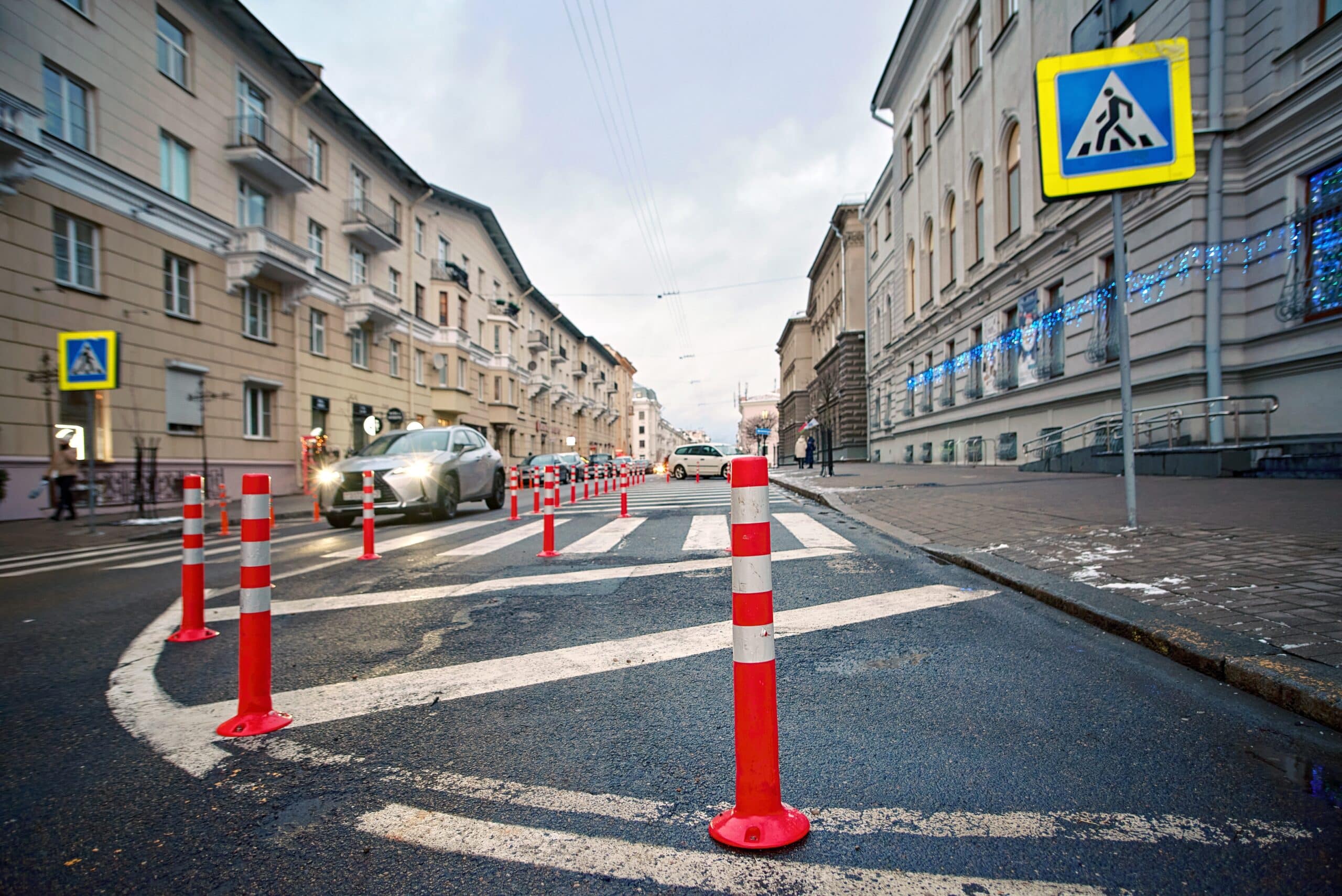Have you ever noticed those sturdy posts installed on sidewalks, parking lots, or in front of buildings? These are traffic bollards, and they serve a crucial role in controlling vehicle access, enhancing pedestrian safety, and protecting properties.
But what are traffic bollards, and why are they used in commercial, residential, and high-security areas? In this blog, we’ll break down their purpose, different types, and how they integrate with access control systems, automated gate operators, and traffic control devices.
Traffic Bollards
Traffic bollards are short, sturdy vertical posts designed to regulate vehicle movement and enhance security. They restrict unauthorized entry, ensure pedestrian safety, and shield buildings, storefronts, and public areas from potential collisions. Bollards help control and direct traffic flow, ensuring smoother and safer transportation.
Commonly found in parking lots, sidewalks, government facilities, and high-security zones, they create barriers that restrict vehicle access while allowing pedestrian movement. Available in various materials like steel, concrete, and plastic, bollards serve both functional and aesthetic purposes. Whether fixed, retractable, or removable, they play a crucial role in urban planning, improving safety and organization in public spaces.
Related Article: Understanding Bollards: Types, Uses, and Benefits
Benefits of Traffic Bollards
1. Prevent Unauthorized Vehicle Entry
Bollards act as physical barriers, blocking unauthorized vehicles from restricted areas like private properties, pedestrian zones, and sensitive locations. By preventing forced vehicle access, they enhance security, deter criminal activities, and reduce accidental intrusions. Commonly used in storefronts, government buildings, and commercial spaces, bollards reinforce access control. They contribute to a safer urban environment by ensuring that only permitted vehicles enter designated zones, minimizing potential risks to people and property.
2. Enhance Pedestrian Safety
Traffic bollards establish distinct separations between walkways and roadways, enhancing pedestrian safety. Found in shopping districts, parks, and sidewalks, they prevent cars from encroaching on pedestrian zones, reducing accident risks. Bollards guide vehicles along designated paths, improving navigation and organization in busy areas. Their strategic placement helps protect vulnerable road users, such as cyclists and children, making urban spaces more secure, walkable, and pedestrian-friendly for daily activities.
3. Protect Buildings and Public Spaces
Bollards shield buildings, storefronts, and public areas from vehicle crashes, whether accidental or intentional. They absorb impact forces, reducing damage and ensuring pedestrian safety. Commonly installed in high-traffic areas, they serve as protective barriers for businesses, banks, and government institutions. Their presence helps mitigate risks associated with reckless driving and vehicle-related attacks, reinforcing perimeter security. Additionally, they can be designed to blend aesthetically with urban landscapes, maintaining functionality and style.
4. Control and Direct Traffic Flow
Strategically placed bollards help manage vehicle movement, guiding drivers along designated paths. They regulate traffic flow in parking lots, roads, and intersections, preventing congestion and ensuring safer transportation. Bollards reduce road hazards and enhance traffic flow by preventing illegal turns and lane violations. Their use in urban planning, alongside signs and road markings, enhances order. In emergencies, collapsible models allow first responders to navigate restricted zones swiftly and safely.
5. Versatile Applications
Bollards are widely installed in locations requiring controlled vehicle access, including parking lots, sidewalks, and government facilities. They reinforce security in high-risk areas while allowing pedestrian movement. Their adaptability suits various environments, from temporary event security to permanent perimeter protection. Whether preventing unauthorized parking, marking pedestrian pathways, or enhancing urban aesthetics, bollards offer customized solutions for modern infrastructure needs. Their role in city planning ensures better organization and safer public spaces.
They are widely used in parking lots, sidewalks, government facilities, and high-security zones where vehicle access needs to be restricted.
Related Article: Choosing the Right Security Bollard Crash-Rating
Types of Traffic Bollards

1. Fixed Bollards
Fixed bollards, designed for long-term security, offer strong protection in high-risk locations. Found in storefronts, pedestrian zones, and government buildings, they block unauthorized vehicle access effectively. Made from materials like steel or concrete, they offer superior impact resistance. Fixed bollards deter ram-raiding, discourage reckless driving, and strengthen urban security. Professionally installed, they integrate seamlessly into city infrastructure, balancing safety with aesthetics in commercial, industrial, and residential spaces.
2. Retractable Bollards
Retractable or automatic bollards adjust as needed, allowing controlled access. Often integrated with security systems, they work with keypads, biometric readers, and remote controls. Common in commercial properties, government buildings, and private driveways, they provide flexible access control while maintaining security. Made from high-strength materials, they resist impact and weather conditions. Their automated operation improves convenience, making them ideal for emergency routes, restricted parking zones, and high-security environments.
3. Removable Bollards
Removable bollards offer a temporary yet effective solution for traffic control and security. Unlike fixed models, they can be manually detached when needed, making them ideal for event security, seasonal pedestrian zones, and temporary road closures. Made from steel, aluminum, or heavy-duty plastic, they balance durability with portability. Used in parking lots, outdoor markets, and sports venues, they provide flexible access control. Easy to install and store, they adapt to changing urban traffic management needs.
4. Traffic Guard Bollards
Designed to enhance pedestrian safety, traffic guard bollards separate walkways from vehicle lanes. Commonly found near bike lanes, sidewalks, and parking areas, they prevent unauthorized vehicle encroachment. Constructed from materials like steel, plastic, or rubber, they offer various levels of impact resistance. Some models feature bright colors or reflective coatings for visibility in low-light conditions. Their strategic placement improves road safety for cyclists, pedestrians, and public transport users, reducing accident risks in busy areas.
5. Crash-Rated Bollards
Crash-rated bollards are engineered to stop vehicles on impact, preventing security breaches and collisions. Used in government buildings, airports, and military bases, they provide high-level protection against high-speed threats. These bollards undergo rigorous impact testing and are rated based on their ability to withstand force. Made from reinforced steel and concrete, they are sometimes retractable for controlled access. Their role in security planning helps safeguard critical infrastructure, minimizing potential vehicular threats effectively.
Related Article: Integrating Security Bollards into Your Safety Plan
Why Are Traffic Bollards Important?
1. Security and Anti-Theft Protection
Bollards deter vehicle-driven theft and forced entry attempts, acting as barriers against ram-raiding. Used in banks, retail stores, and commercial zones, they reinforce perimeter security. Made from reinforced steel or concrete, they absorb impact and protect assets. Security bollards restrict unauthorized access, allowing businesses and institutions to enhance protection. Their integration with advanced security systems strengthens defense against theft, vandalism, and vehicle-based threats, improving overall safety and asset management.
2. Parking Lot Safety
Bollards improve parking lot safety by guiding vehicles, protecting pedestrians, and marking designated spaces. Installed at entry points, pedestrian crossings, and loading areas, they help prevent collisions and unauthorized parking. Designed to absorb minor impacts, they minimize damage to cars and infrastructure. Reflective coatings enhance visibility at night, ensuring better navigation. Their use in commercial, residential, and public parking areas creates a structured and secure environment, benefiting both drivers and pedestrians.
3. Perimeter Protection
Bollards enhance perimeter security by working alongside gate operators, barriers, and surveillance systems. Installed around government facilities, military bases, and data centers, they prevent unauthorized vehicle access. Constructed from impact-resistant materials, they create a strong defense against potential threats. Some models allow controlled access for emergency responders. Their strategic placement reinforces security measures, protecting sensitive sites from vehicle intrusions, terrorist attacks, and accidental crashes while maintaining accessibility when needed.
4. Smart Access Control
Integrated with automated systems, smart access control bollards enhance vehicle access control using keycards, biometrics, or remote authentication. Used in businesses, private residences, and government buildings, they provide seamless security management. Retractable models adjust based on security protocols, ensuring efficiency without manual intervention. Their advanced technology streamlines entry processes while preventing unauthorized vehicle access. Ideal for high-risk locations, smart bollards optimize security, improve accessibility, and offer innovative solutions for modern infrastructure needs.
5. Traffic Flow Management
Traffic bollards regulate vehicle movement in high-traffic areas, preventing congestion and improving road safety. Found at intersections, commercial zones, and pedestrian crossings, they define lanes and restrict illegal maneuvers. Flexible or collapsible models allow emergency vehicles to bypass restrictions when necessary. Used alongside traffic signs and signals, bollards contribute to smoother navigation. Their implementation in urban planning enhances organization, reducing accident risks and ensuring a controlled, efficient traffic system for all road users.
Related Article: Maximizing Safety: The Benefits of Crash-Proof Bollards
Common Applications of Traffic Bollards
1. Commercial Properties
Businesses rely on security bollards to protect storefronts, parking areas, and entryways from vehicle-related accidents and unauthorized access. These bollards serve as barriers that prevent ram-raiding incidents, safeguard pedestrians, and enhance overall security. Often made from steel or concrete, they provide durability and impact resistance. Some businesses opt for decorative bollards that blend seamlessly with urban aesthetics while maintaining strong security features. Parking lot bollards help regulate vehicle flow and prevent illegal parking. By integrating security bollards into their property design, commercial establishments improve safety, minimize property damage risks and create a secure environment for customers and employees.
2. Government Facilities
Government facilities, including embassies, military bases, and federal buildings, require high-security measures to prevent unauthorized vehicle access. Anti-ram bollards and crash-rated systems provide robust protection against potential threats, such as terrorist attacks or accidental crashes. These bollards are strategically installed at entry points, pedestrian zones, and parking areas to reinforce security perimeters. Made from reinforced steel and concrete, they can withstand high-impact forces, stopping vehicles from breaching restricted areas. Certain security bollards are retractable, enabling controlled entry for authorized individuals. Their presence is essential in safeguarding critical infrastructure, protecting government assets, and ensuring public safety in high-risk locations.
3. Industrial Sites
Factories, warehouses, and manufacturing plants utilize bollards for perimeter security, regulating vehicle access, and improving workplace safety. These bollards are installed around loading docks, storage areas, and facility entrances to prevent unauthorized access and accidental collisions. Heavy-duty industrial bollards help protect workers, machinery, and inventory from potential vehicle damage. Some bollards are designed with high-visibility coatings to improve safety in busy environments. In hazardous zones, impact-resistant bollards minimize risks by guiding vehicles along designated paths. By incorporating security bollards into their infrastructure, industrial sites maintain better traffic management, reduce operational hazards, and safeguard valuable assets effectively.
4. Residential Communities
Homeowners and gated communities install bollards as part of smart home security solutions to enhance driveway and property protection. Bollards help prevent unauthorized vehicle access, block unwanted traffic, and improve pedestrian safety in residential areas. Some homeowners use retractable or removable bollards to control access as needed. Modern bollards can integrate with home automation systems, allowing remote control via smartphone apps or biometric authentication. Decorative bollards enhance curb appeal while maintaining security. Whether used for private driveways, community entrances, or pedestrian walkways, bollards provide an added layer of protection, ensuring a safer and more controlled residential environment.
5. High-Traffic Public Spaces
In pedestrian-heavy areas like parks, shopping centers, and city streets, bollards help separate foot traffic from vehicles, reducing accident risks. Street bollards are commonly installed along sidewalks, bike lanes, and plazas to create clear boundaries between pedestrians and moving cars. Many public spaces use flexible or collapsible bollards that allow emergency vehicle access when needed. These bollards often feature bright colors or reflective materials for increased visibility at night. By improving traffic organization and pedestrian safety, bollards contribute to urban planning efforts, making public spaces more accessible, functional, and secure for residents, tourists, and daily commuters.
Related Article: Fixed Bollards vs. Retractable Bollards: What’s Best for You?
Final Thoughts:
Understanding what traffic bollards are helps you choose the right ones for your property’s safety and access control needs. Whether you need removable traffic bollards, retractable bollards, or traffic guard bollards, investing in the right solution ensures long-term protection.
Looking for high-quality traffic bollards? Visit R3 Access Inc. today to explore the best bollard traffic solutions!
FAQs:
What is a traffic bollard?
A traffic bollard is a sturdy post used to control vehicle movement, improve pedestrian safety, and protect buildings from collisions.
Do traffic bollards prevent car theft?
Yes! Bollard posts create a strong barrier that prevents thieves from driving away with vehicles or crashing into storefronts.
Will a traffic bollards stop a car?
Yes, high-impact bollards can stop or slow down a vehicle, depending on their material and installation.
How much does traffic bollards cost?
Prices vary from $200 for basic models to $2,000 or more for crash-rated security bollards.


